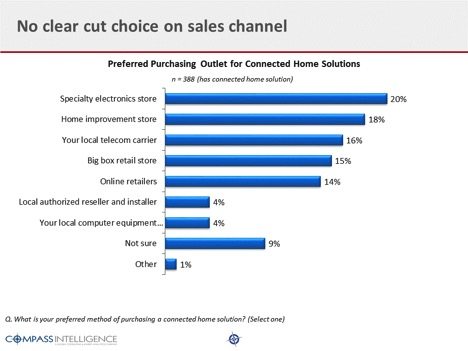The connected home market is witnessing growth that is targeting the mass market. Security and alarm monitoring are the solutions that historically drove demand in this segment; however that is starting to slowly change. Leading the way is energy management. Companies, such as Nest and Honeywell to name a few, have developed smart thermostats. Because energy demands are increasing around the world, utility companies are also participating in the value chain, which is helping to boost growth. Reducing consumption during peak hours is a priority for those companies, especially in regions with limited energy supply. Electric vehicles are also causing stress on the grid. With rising electricity demands, utilities are becoming more proactive.
For companies that participate in the connected home space, utilities are helping to raise consumer awareness and driving growth in other solutions. Today we see unique solutions in connected lighting and smart appliances. Several companies are using multiple methods for communication such as ZigBee, Wi-Fi and more. There is an increasing number of companies that provide hubs that allow multiple devices to connect to it, such as security cameras, smoke detectors, lighting, smart plugs and other devices. There is also innovation taking place for water management, especially in places like California where water scarcity is major concern along with other regions of the world. In addition to the products mentioned, connected medical devices are also growing in demand.
With all of the innovation taking place in the connected home market, one challenge still remains: What is the best sales channel for the connected home market? Some might say retail, but is that truly the case because the do-it-yourself market has not really taken off? Furthermore, it is considered a good channel for early adopters and hobbyists. Door-to-door sales are sometimes mentioned but this model is best geared toward services like traditional alarm monitoring. New-home builders are out of the question because their main focus is to upsell customers into high-end upgrades. We see mobile operators trying with their retail outlets, however their sales teams are good at selling mobile devices but not connected home solutions. In a published study on the Connected Home market, Compass Intelligence asked consumers for their preferred sales channel. The chart below displays the results from the survey.
As one can see, there is no clear-cut choice for the best sales model. Since the “Internet of Things” is transforming business and Michael Porter mentioned at LiveWorx 2015 that business will be transformed from IoT, is it safe to say that the sales channel that will truly help drive the connected home does not yet exist? Could it be a hybrid model of some of the channels mentioned above?
To crack the sales code will require a new model. The reason is because the demographics in the home vary. For example, a household with elderly or someone who has a chronic illness will require m-health solutions and, depending on the illness, may require additional monitoring. A household with young children will require different devices. A home with teenagers will require different devices. The type of housing varies such as single-family home, condo, etc., then throw in lifestyle differences from one region to the next. Further complicating the channel is the convergence of the connected car and home.
There is great potential in the connected home market with pent up demand, but it is going to require an innovative approach to the sales channel. Furthermore, it is going to require companies to have better insight into their customers before going to market. Compass Intelligence believes the companies that will be successful in the connected home market will be those that will be able to develop innovative go-to-market strategies at the same level they create new and dynamic products. The question now is who is going to be the disruptor to win?
Keith Robinson is a senior strategist and consultant and the M2M practice lead at Compass Intelligence. Robinson directs the syndicated and consulting content for the M2M practice. He brings a considerable amount of project management and content development experience to Compass Intelligence’s M2M team. This experience has created new ways to improve clients’ experience and to better utilize business intelligence with various stakeholders throughout the ecosystem. Robinson has experience in monitoring several industries that include: M2M, telecom, retail, electronic manufacturing, transportation, industrial process control, medical devices, building automation, consumer electronics and the connected home. Robinson holds a B.A. from Fisk University and currently resides in Atlanta with his wife and two kids.
Editor’s Note: Welcome to Analyst Angle. We’ve collected a group of the industry’s leading analysts to give their outlook on the hot topics in the wireless industry.



